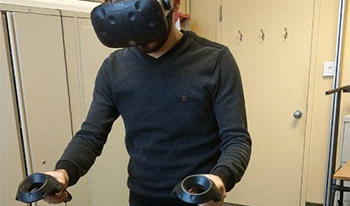References
1ArsenaultR.WareC.2004The importance of stereo and eye-coupled perspective for eye-hand coordination in fish tank VRPresence Teleoperators Virtual Environ.1354910.1162/1054746042545300
2AygarE.WareC.RogersD.2018The contribution of stereoscopic and motion depth cues to the perception of structures in 3D point cloudsACM Trans. Appl. Percept15110.1145/3147914
3BarfieldW.HendrixC.Visualizing the structure of virtual objects using head tracked stereoscopic displaysProc. of IEEE 1997 Annual Int’l. Symposium on Virtual Reality1997IEEEPiscataway, NJ114
4BarfieldW.ZeltzerdSheridanT.SlaterM.Presence and performance within virtual environmentsVirtual Environ. Adv. Interface Des.1995475Oxford University PressInc.198 Madison Ave. New York, NY
5BoritzJ.BoothK. S.A study of interactive 3D point location in a computer simulated virtual environmentProc. ACM Symposium on Virtual Reality Software and Technology1997Association for Computing MachineryNew York, NY181
6BoustilaS.BechmannD.CapobiancoA.
7EllisS. R.1996Presence of mind: a reaction to Thomas Sheridan’s ‘further musings on the psychophysics of presence’Presence Teleoperators Virtual Environ.524710.1162/pres.1996.5.2.247
8FreemanJ.AvonsS. E.PearsonD.HarrisonD.LodgeN.Behavioral realism as a metric of presence1st Int. Wkshp. on Presence1998International Society for Presence Research
9GibsonE. J.WalkR. D.1960The ‘visual cliff’Sci. Am.202647164–7110.1038/scientificamerican0460-64
10HassaineD.HollimanN. S.LiversedgeS. P.2010Investigating the performance of path-searching tasks in depth on multiview displaysACM Trans. Appl. Percept8810.1145/1857893.1857901
11IJsselsteijnW. A.De RidderH.1998Measuring temporal variations in presencePresence Shar. Virtual Environ. Work. Univ. Coll. Lond.10
12IjsselsteijnW.De RidderH.FreemanJ.AvonsS. E.BouwhuisD.2001Effects of stereoscopic presentation, image motion, and screen size on subjective and objective corroborative measures of presencePresence Teleoperators Virtual Environ.1029810.1162/105474601300343621
13LeeK. M.2004Presence, explicatedCommun. Theory142710.1111/j.1468-2885.2004.tb00302.x
14LionD. M.
15LombardM.DittonT.1997At the heart of it all: the concept of presenceJ. Comput. Commun.3JCMC321
16McCallR.O’NeilS.CarrollF.
17MeehanM.InskoB.WhittonM.BrooksF. P.2002Physiological measures of presence in stressful virtual environmentsACM Trans. Graph.2164510.1145/566654.566630
18MilesW. R.1930Ocular dominance in human adults,J. Gen. Psychol.341210.1080/00221309.1930.9918218
19NaepflinU.MenozziM.2001Can movement parallax compensate lacking stereopsis in spatial explorative search tasks?Displays2215710.1016/S0141-9382(01)00067-1
20NoëA.Action in Perception2004MIT PressCambridge, Massachusetts
21ReganJ. K. O.NoëA.2001A sensorimotor account of vision and visual consciousnessBehav. Brain Sci.2493910.1017/S0140525X01000115
22RogersB.GrahamM.1982Similarities between motion parallax and stereopsis in human depth perceptionVis. Res.2226110.1016/0042-6989(82)90126-2
23RegenbrechtH. T.SchubertT. W.Measuring presence in virtual environmentsProc. Human Computer Interface Int’l., San Francisco1997SpringerNew York
24SchubertT.FiredmannF.RegenbrechtH.Embodied presence in virtual environmentsVisual Representations and Interpretations1999Springer-VerlagLondon269
25SheridanT. B.1996Further musings on the psychophysics of presencePresence Teleoperators Virtual Environ.524110.1162/pres.1996.5.2.241
26SlaterM.1999Measuring presence: a response to the Witmer and Singer presence questionnairePresence856010.1162/105474699566477
27SlaterM.2009Place illusion and plausibility can lead to realistic behaviour in immersive virtual environmentsPhil. Trans. R. Soc. B Biol. Sci.364355710.1098/rstb.2009.0138
28SlaterM.KhannaP.MortensenJ.YuI.2009Visual realism enhances realistic response in an immersive virtual environmentIEEE Comput. Graph. Appl.297610.1109/MCG.2009.55
29SlaterM.UsohM.SteedA.1994Depth of presence in virtual environmentsPresence Teleoperators Virtual Environ.313010.1162/pres.1994.3.2.130
30SlaterM.UsohM.SteedA.1995Taking steps: the influence of a walking technique on presence in virtual realityACM Trans. Comput. Interact.220110.1145/210079.210084
31SollenbergerR. L.MilgramP.1993Effects of stereoscopic and rotational displays in a three-dimensional path-tracing taskHum. Factors3548310.1177/001872089303500306
32UsohM.ArthurK. W.WhittonM. C.BastosR.SteedA.SlaterM.Brooks JrF. P.
33Van BeurdenM. H. P. H.KuijstersA.IJsselsteijnW. A.2010Performance of a path tracing task using stereoscopic and motion based depth cues2010 2nd Int’l. Workshop on Quality of Multimedia Experience, QoMEX 2010 -Proceedings176IEEEPiscataway, NJ
34WareC.ArthurK.BoothK. S.1993Fish tank virtual realityProc. INTERACT’93 and CHI’93 Conf. on Human Factors in Computing Systems37ACMNew York, NY
35WareC.FranckG.1996Evaluating stereo and motion cues for visualizing information nets in three dimensionsACM Trans. Graph.1512110.1145/234972.234975
36WareC.MitchellP.Reevaluating stereo and motion cues for visualizing graphs in three dimensionsAPGV ’05 Proc. 2nd Symp. Appl. Percept. Graph. Vis2005Association for Computing MachineryNew York, NY51
37WareC.MitchellP.2008Visualizing graphs in three dimensionsACM Trans. Appl. Percept5210.1145/1279640.1279642
38WitmerB. G.SingerM. J.1998Measuring presence in virtual environments: a presence questionnairePresence722510.1162/105474698565686

 Find this author on Google Scholar
Find this author on Google Scholar Find this author on PubMed
Find this author on PubMed